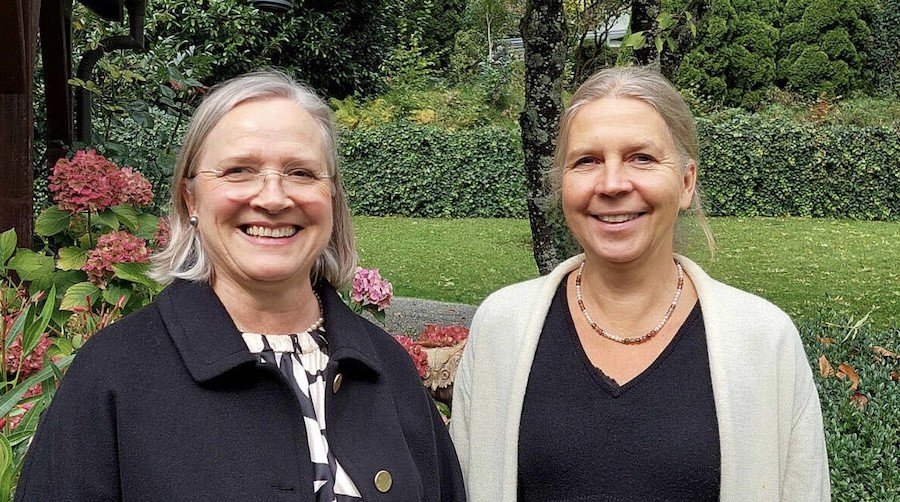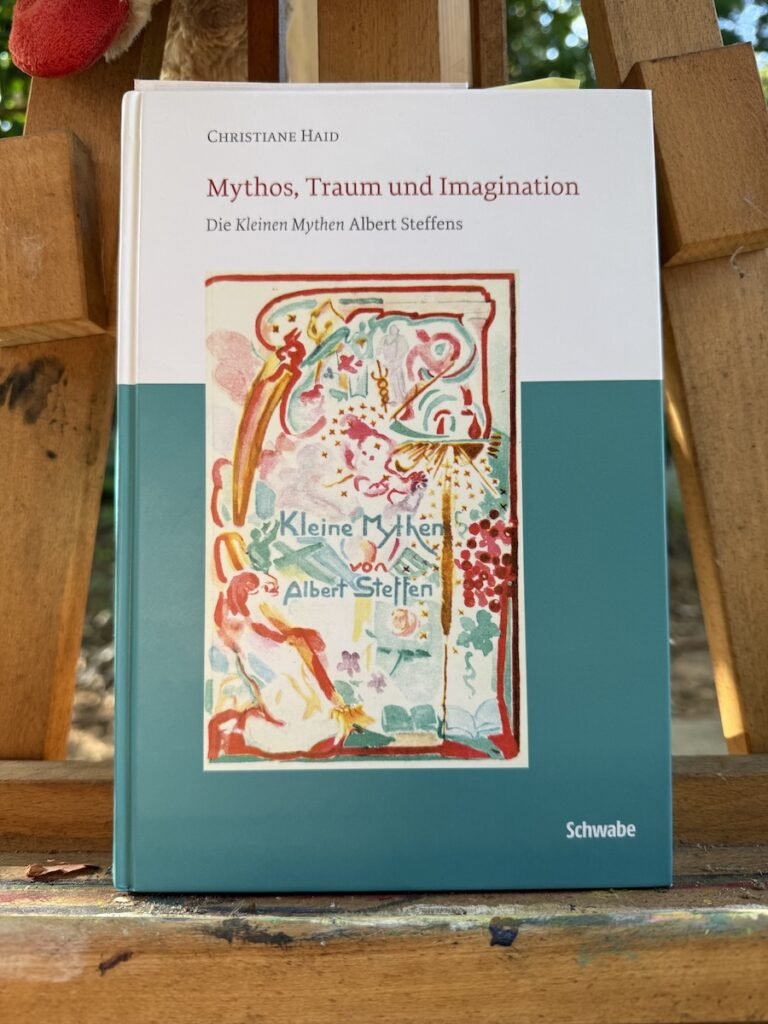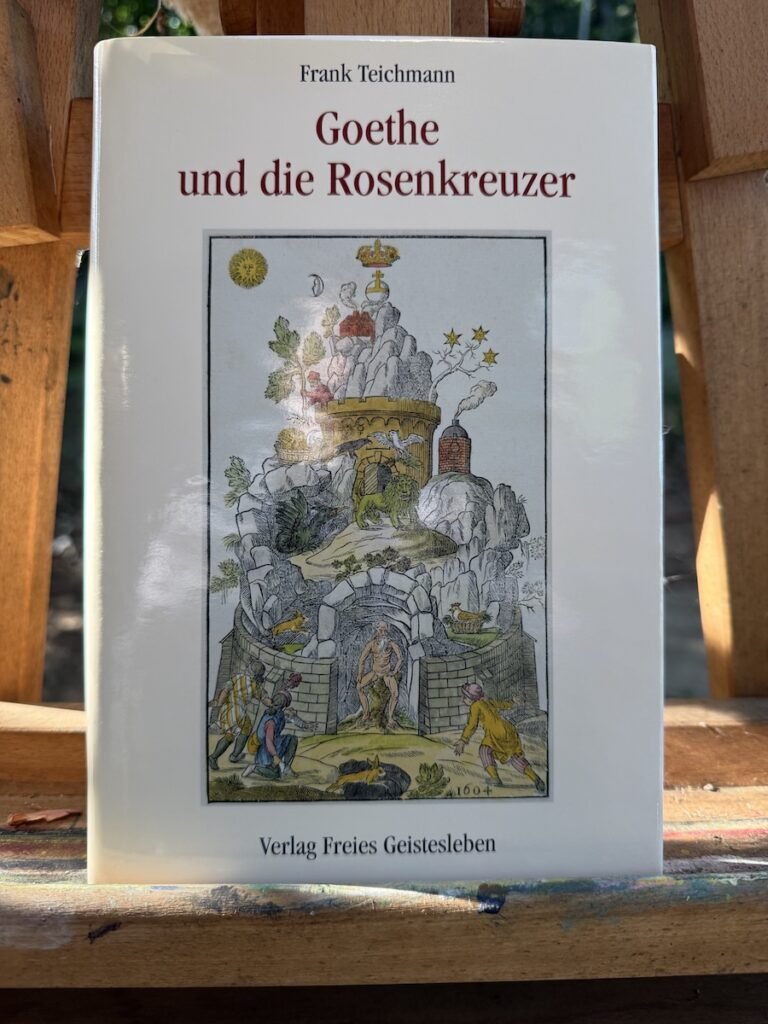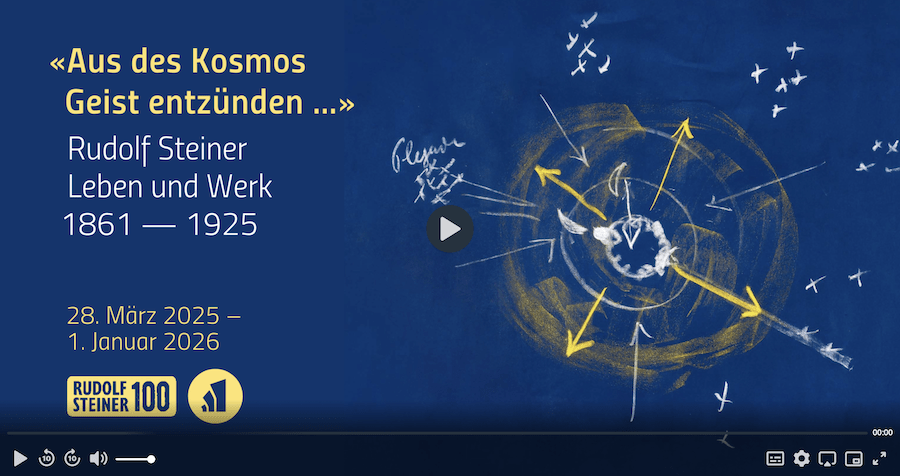Section Leader Christiane Haid & STIL Editor Ariane Eichenberg
Dear Friends:
STIL magazine is a German-language quarterly publication of the Section for the Literary Arts & Humanities and the Section for the Visual Arts. Both Sections are under the leadership of Christiane Haid. I have reported on STIL several times on this website over the years. The most recent post featured the June 2025 issue (St. John’s).
STIL is available in German to North American readers for single issue purchase. Click here for information.
Presently, this excellent publication is only available in German, but efforts are underway to launch an English-language edition. This is one of the topics discussed in the interview that follows. This interview first appeared at Michaelmas 2025 on the website for the German Anthroposophical Society (AGiD.Aktuell). Olivia Girard conducted the interview. I translated it with permission.
Introduction
STIL magazine was founded in 1979 by Wilhelm Oberhuber under the title STIL: Goetheanistisches Bilden und Bauen. From 2009 onwards it was published quarterly by Verlag am Goetheanum under the expanded title STIL: Goetheanismus in Kunst und Wissenschaft. Michael Kurtz took over the editorship from Wilhelm Oberhuber in 2009 and handed it over to Ariane Eichenberg and Christiane Haid in 2020. STIL thus became the organ of the Section for Beautiful Sciences (Section for the Literary Arts & Humanities) and the Section for the Visual Arts, and it has been published by both sections since April 2025. Over the years, STIL has developed into an important forum for artistic and scientific issues.
Interview
Olivia Girard: How did you get involved in the work of the Section?
Christiane Haid: The key and answer to your question is Novalis, whom I have loved since I was fourteen. During my years in Heidelberg at the Friedrich von Hardenberg Institute, I wrote my first essay on “History as a Memory of the Future: A Poetic Inquiry.” This text led Martina Maria Sam to bring me to Dornach in 2001 as a research assistant to help build up the Section. Until then, I had spent eight years studying the history of anthroposophy as a worldwide cultural impulse. From 2001 onwards, I helped to build up the Section for the Fine Arts until I was asked to work at the Albert Steffen Foundation. This led me to engage even more intensively with the life and work of the first section leader, Albert Steffen.
While active in this way, I wrote a dissertation on the topic of Myth, Dream, and Imagination: The Little Myths of Albert Steffen at the University of Hamburg, which was published by Schwabe Verlag Basel in 2012.
This was followed by my position as director of the at the Goetheanum Verlag from 2009 to 2025. In 2012, I was asked to take over as head of the Section for Literary Arts & Humanities, which in German is called the Section for the Beautiful Sciences. Wilhelm Oberhuber had already asked me in 2008 if I wanted to take over the editorship of STIL, but the right time to do that only arrived in 2020 when I also accepted the leadership of the Section for Visual Arts. Along with my colleague Ariane Eichenberg, I recognized that STIL presented an ideal opportunity to make the central themes and tasks of the sections’ work visible. Such themes included also the work and biographies of artists. This new beginning coincided with a complete graphic redesign of the magazine by Wolfram Schildt from Berlin. Wolfram Schildt’s design choices complement wonderfully the magazine’s themes and topics. Each issue brings new delight and surprises.
Ariane Eichenberg: A few words about persons involved.
As I step back and consider this personal element, I find such human encounters fundamentally crucial for initiatives. And yet, these person-to-person encounters are becoming increasingly rare.
Frank Teichmann opened my eyes to this section. He gave many lectures and seminars in the Section for the Beautiful Sciences—for example, on the Egyptian and Greek mysteries, on Chartres, and most recently on Goethe and the Rosicrucians.
I had already met Christiane Haid in the 1990s at a Wilhelm Meister conference. Although it took several years before we began our collaboration, a thread to that future had been spun. And after a long conversation about the effect of literature and language on people, it was clear that these questions belong at the heart of our Section for the Beautiful Sciences. How can writing and language be a bridge to the spiritual?
Olivia Girard: The journal STIL has a long history. Founded in 1979, it has been published under an expanded title since 2009 and was redesigned and refocused on Michaelmas 2020. How would you describe the common thread that has sustained the journal forward through the decades?
Christiane Haid: Well, I would point to the exceptionally high standard of the articles. STIL was founded as a scientific journal, and it has remained so to this day. When it was still published under the name “Goetheanistisches Bilden und Bauen” it was primarily an architecture magazine. The range of content has steadily expanded, however. During Michael Kurtz’s era as editor, painting, music, literature, and the fine arts, and various aspects of cultural history were added. There were also recurrent issues dedicated thematically to individual countries—for example, the the British Isles.
Concern and interest for the being human, concern and interest for human creativity in all the arts—as well as philosophy and anthroposophy—these are fundamental concerns of the heart at the core of STIL.
We approach this from two points of view which at first may strike readers as contradictory: the view of art and the view of science. However, art and science are indeed at the heart of the Section for the Beautiful Sciences. The origin point here of course is Goethe, for whom art and science were complementary modes of knowing. Goethe describes in a wonderfully impressive way how these two core human activities arise from a common source spring. Goethe embodied both cultures of art and science, and thus Goethe altered our understand of science and art in a fundamental way. One could say that Goethe humanized art and science. The fact that art and science still appear to be separated today is due to attitudes of the eighteenth and nineteenth centuries—two centuries that gave rise to the notion of “two separate cultures”—art and science—in the first place. The future lies in a renewed, consciously shaped re-union of art and science. By bringing science closer to art, science is transformed, humanly recentered, and elevated to wholeness through the ideal of beauty. Art, in turn, can be elevated from the purely unconscious and rather subjective realm to something that can be grasped by law and made generally accessible through creative and non-rational insight.
Ariane Eichenberg: The magazine is supported first and foremost by readers who not only subscribe to STIL but who also read it and are inspired to see things differently. On the other hand, the Goethean approach forms the common thread: the artistic, which is based on scientifically accurate knowledge, and the scientific, which becomes artistic through the individual. In Michael Kurtz’s time, it was more of a musical thread, while in our time it is a linguistic-philosophical or even architectural thread with Pieter van der Ree from the Section for the Visual Arts. But weaving all together is an abiding interest in understanding culture, art, science, and, in the broadest sense of the word, religion. We provide a larger context in which to locate these in our world today.
Olivia Girard: Over time, the thematic focus has also broadened. Which aspects of Goetheanism are particularly important to you today?
Christiane Haid: The word Goetheanism may conjure up images of protocol reports or scientific methodologies or biology. For us, Goethe’s worldview is central here: namely, the way he observed, researched, and reflected. It is because of Goethe’s way of seeing, reflecting and researching that his art and his science flourished. A very early lecture by Rudolf Steiner, Goethe as the Father of a New Science of Aesthetics, wonderfully sums up our central concerns.
The lecture asks us to elevate the material realm through artistic activity—and one might well extend this to scientific activity—in such a way that the material realm is transformed through artistic/scientific activity. It is a kind of resurrection process in the Rosicrucian sense.
Ariane Eichenberg: For me as a literary scholar, literature and language are central concerns, and this includes the language of anthroposophy and Rudolf Steiner. The main theme for Michaelmas 2025 is: Reading and Understanding Rudolf Steiner. Various authors explore the language and thought processes of Rudolf Steiner in his written works. For me, it was crucial to show how the spiritual manifests itself in language when we read thoughtfully and thus recreate the text each time we engage with it. The writing is a “score” (an expression Rudolf Steiner used for The Philosophy of Freedom and An Outline of Esoteric Science) that we can practice repeatedly. This is not about the reception of content, but about movement of thought. In a first step, literary terms are helpful here, but in further steps they must be transferred to the humanities.
Olivia Girard: STIL is now published quarterly by the Section for the Beautiful Sciences and the Section for the Visual Arts. How does this collaboration work out in terms of everyday editorial practice?
Christiane Haid: It is a very close interconnection, exactly as I described earlier. Both fields enrich each other without blurring their contours, so that socially, too, they are two circles that form their own contexts with very different people, but who also learn from each other, challenge each other, and enrich each other.
Ariane Eichenberg: The Sections for Beautiful Sciences and Visual Arts are both headed by Christiane Haid. So, there is already a connection and an ongoing exchange. This can be seen, for example, in the major Rudolf Steiner exhibition Ignited by the Spirit of the Cosmos... at the Goetheanum, which will be on display until summer 2026.
Christiane Haid initiated the exhibition, Pieter van der Ree curated it, and we exchanged ideas about texts and images together. This also means a close cooperative relationship with STIL. Stil would not be STIL without the visual arts. It thrives on the images and artwork and conversations with artists
Olivia Girard: In an age dominated by digital media, you continue to rely on a printed magazine. What role does the printed format play for your readers?
Christiane Haid: We attach great importance to a visually and haptically beautiful and appealing design—something one can hold and touch and feel.
STIL allows readers to escape from their everyday screen life and take a creative break without electricity and nervous stimuli. The articles are often challenging and demanding. They require concentration and perseverance, as they are usually much longer than articles in other magazines. This is particularly important to us, as we strive to provide in-depth reading at a high level and hope that, even in our fast-paced world, there will always be readers who are willing to take the time and make the effort. The issues remain relevant beyond their publication date. Thanks to their thematic focus, they can be read again and again, even years later, just like books.
Ariane Eichenberg: We can’t say for sure, as we haven’t conducted a survey to evaluate this question. However, I assume that we have readers who specifically want this printed format. Our articles are unusually long. We could make a book out of every issue of STIL. In addition, the topics and language are sophisticated. These are not texts that you can just skim. Sometimes you might want to go back to read something again; you might even want to highlight something. Of course, you can do all of that in digital format too, but overall, it speaks in favor of a print edition that invites you to linger. For an English version of STIL, which is in the works, we would initially want to use a digital format, however.
Personally, I prefer the printed magazine. When I’m looking for something in an article, I always reach for my stack of STIL magazines next to my desk, and I read the printed version. The beautiful heavy paper, the large format, and the look of the layout always make me want to read a little further and leaf through the pages.
Olivia Girard: When you think about the coming years, what developments would you like to see for STIL and which topics would you particularly like to pursue?
Christiane Haid: We want our magazine to provide inner orientation and depth. We also want to address controversial topics without becoming political. It’s amazing that Goethe, in the turmoil of the French Revolution, was intensely preoccupied with Persia and Hafiz, and that Schiller wrote his letters on the aesthetic education of the human being. It seems to me that the profound effect of inner cultural education through poetry, art, and philosophy is underestimated and downplayed. People look for the big lever, and they forget that it is the subtle, quiet tones and impulses that touch and change people. The focus of the journals often arises from the content of conferences held by the two sections at the Goetheanum. We also seek to address relevant topics and questions based on our perception of current events, encounters with people, and inner concerns and impulses that come our way. The 100th anniversary of Rudolf Steiner’s death seems to me to mark an important turning point. I have the impression that there should be a new step for anthroposophy in cultural and contemporary events, imbued with life, without any missionary zeal or superior knowledge, but rather out of a deep interest in human beings and their existential questions that arise in these challenging and difficult times.
Ariane Eichenberg: Of course, we would like to have more readers. We don’t aim to be sold at airports—we would have to bend over backwards too much for that! But it would be helpful if we could eventually become self-sustaining. It’s nice to hear, “What a great magazine you’re producing!” It would be even nicer if more people bought and read it. That’s the external aspect. An internal goal is to connect anthroposophical topics more closely with contemporary phenomena. At present, such phenomena have been wars primarily, but we also focus on technological developments that are almost destroying our understanding of what it means to be human. Looking into these abysses, finding ways of viewing them from an anthroposophical perspective, and being able to articulate what we behold—this is a central task.
About the Publisher and Editor
Dr. phil. Christiane Haid, born in 1965, studied German language and literature, history, art, and education in Freiburg and Hamburg. Research assistant at the Friedrich von Hardenberg Institute for Cultural Studies, researching the history of anthroposophy in the 20th century. 2001 Research assistant in the Section for the Fine Arts. In 2006, cultural scientist at the Albert Steffen Foundation in Dornach. From 2009, director of the Goetheanum Publishing House. Doctorate in literary studies: Myth, Dream, and Imagination. The Little Myths of Albert Steffen, Basel 2012. Since 2012, director of the Section for Beautiful Sciences at the Goetheanum. 2019 to 2025 Program director of the Goetheanum Verlag. 2024 Director of the Art Study Year at the Goetheanum. Current research topics: Humanization of the human being through literature, AI and transhumanism, aesthetics and Rudolf Steiner’s theory of the senses, Christian Morgenstern, Rilke, Novalis, Goethe, the works of Rudolf Steiner, among others.
Dr. phil. Ariane Eichenberg, born in 1968; studied anthroposophy in Stuttgart, German language and literature, and Slavic studies in Heidelberg and Hamburg. Doctorate on Shoah literature; 2004 collaborated on the research project “Remembrance and Memory” at the Institute for Advanced Study in the Humanities (KWI) in Essen. From 2005 research assistant in the research project “The Search for Democracy in the Shadow of Violence. Concepts of Family and Peaceful Society between the End of World War II and the Beginning of the 21st Century” (Cologne). From 2005 to 2022, editor of the magazine “Erziehungskunst” (The Art of Education). Since 2007, German teacher at the Uhlandshöhe Free Waldorf School. 2010/11 Research assistant at the University of Stuttgart, 2012/13 at the University of Tübingen. Since 2015, employee of the Section for the Beautiful Sciences. Publications about memory and remembrance, on literary treatments of traumatic events. Research focus is the significance of literature and language in the digital age.
10.09.25




 Click here to view the video.
Click here to view the video.